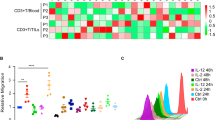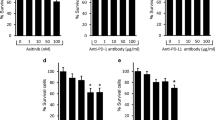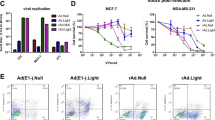Abstract
OBP-301 (a telomerase-specific, replication-competent adenovirus with hTERT promoter) was constructed in a previous study and it showed a strong anticancer effect by inducing cell lysis in human lung and prostate cancer cells. This study investigated the effectiveness of a combination therapy of OBP-301 and interleukin-2 (IL-2) in a mouse model of renal cell carcinoma (RCC). The cell-killing effect of OBP-301 was confirmed in vitro in the RENCA cancer cells. In in vivo experiment, luciferase-expressing RENCA cells were implanted in the left kidney and lung of BALB/c mice to prepare the RCC metastatic model. The animals were randomly divided into four treatment groups: PBS, IL-2 alone, OBP-301 alone and the combination. The analyses of orthotopic tumor weight, lung metastasis and luciferin-stained tumor images 14 days after each treatment showed significant tumor growth inhibition in the combination group in comparison with that in the OBP-301- or IL-2-treated groups. In addition, the percentage of regulatory T-cells (Tregs) in the combination group was significantly suppressed in comparison with that in the PBS and single-agent treatment groups. The outcomes of this study suggest that tumor-specific oncolytic immunovirotherapy may become an attractive strategy for the treatment of human RCC.
This is a preview of subscription content, access via your institution
Access options
Subscribe to this journal
Receive 12 print issues and online access
$259.00 per year
only $21.58 per issue
Buy this article
- Purchase on Springer Link
- Instant access to full article PDF
Prices may be subject to local taxes which are calculated during checkout





Similar content being viewed by others
References
Jemal A, Siegel R, Ward E, Murray T, Xu J, Thun MJ . Cancer statistics, 2007. CA Cancer J Clin 2007; 57: 43–66.
Blackburn EH . Structure and function of telomeres. Nature 1991; 350: 569–573.
Kim NW, Piatyszek MA, Prowse KR, Harley CB, West MD, Ho PL et al. Specific association of human telomerase activity with immortal cells and cancer. Science 1994; 266: 2011–2015.
Shay JW, Wright WE . Telomerase activity in human cancer. Curr Opin Oncol 1996; 8: 66–71.
Nakayama J, Tahara H, Tahara E, Saito M, Ito K, Nakamura H et al. Telomerase activation by hTRT in human normal fibroblasts and hepatocellular carcinomas. Nat Genet 1998; 18: 65–68.
Kawashima T, Kagawa S, Kobayashi N, Shirakiya Y, Umeoka T, Teraishi F et al. Telomerase-specific replication-selective virotherapy for human cancer. Clin Cancer Res 2004; 10: 285–292.
Watanabe T, Hioki M, Fujiwara T, Nishizaki M, Kagawa S, Taki M et al. Histone deacetylase inhibitor FR901228 enhances the antitumor effect of telomerase-specific replication-selective adenoviral agent OBP-301 in human lung cancer cells. Exp Cell Res 2006; 312: 256–265.
Kishimoto H, Kojima T, Watanabe Y, Kagawa S, Fujiwara T, Uno F et al. In vivo imaging of lymph node metastasis with telomerase-specific replication-selective adenovirus. Nat Med 2006; 12: 1213–1219.
Huang P, Watanabe M, Kaku H, Kashiwakura Y, Chen J, Saika T et al. Direct and distant antitumor effects of a telomerase-selective oncolytic adenoviral agent, OBP-301, in a mouse prostate cancer model. Cancer Gene Ther 2008; 15: 315–322.
Endo Y, Sakai R, Ouchi M, Onimatsu H, Hioki M, Kagawa S et al. Virus-mediated oncolysis induces danger signal and stimulates cytotoxic T-lymphocyte activity via proteasome activator upregulation. Oncogene 2008; 27: 2375–2381.
Yang JC, Sherry RM, Steinberg SM, Topalian SL, Schwartzentruber DJ, Hwu P et al. Randomized study of high-dose and low-dose interleukin-2 in patients with metastatic renal cancer. J Clin Oncol 2003; 21: 3127–3132.
Negrier S, Escudier B, Lasset C, Douillard JY, Savary J, Chevreau C et al. Recombinant human interleukin-2, recombinant human interferon alfa-2a, or both in metastatic renal-cell carcinoma. Groupe Français d’Immunothérapie. N Engl J Med 1998; 338: 1272–1278.
Watanabe M, Kashiwakura Y, Huang P, Ochiai K, Futami J, Li SA et al. Immunological aspects of REIC/Dkk-3 in monocyte differentiation and tumor regression. Int J Oncol 2009; 34: 657–663.
Watanabe M, Nasu Y, Kashiwakura Y, Kusumi N, Tamayose K, Nagai A et al. Adeno-associated virus 2-mediated intratumoral prostate cancer gene therapy: long-term maspin expression efficiently suppresses tumor growth. Hum Gene Ther 2005; 16: 699–710.
Watanabe M, Kashiwakura Y, Kusumi N, Tamayose K, Nasu Y, Nagai A et al. Adeno-associated virus-mediated human IL-10 gene transfer suppresses the development of experimental autoimmune orchitis. Gene Ther 2005; 12: 1126–1132.
Beyer M, Schultze JL . Regulatory T cells in cancer. Blood 2006; 108: 804–811.
Curiel TJ . Regulatory T cells and treatment of cancer. Curr Opin Immunol 2008; 20: 241–246.
Qin FX . Dynamic behavior and function of Foxp3+ regulatory T cells in tumor bearing host. Cell Mol Immunol 2009; 6: 3–13.
Acknowledgements
This work was supported by a grant from the Ministry of Education, Culture, Sports, Science and Technology's FY2006 ‘Creation of Innovation Centers for Advanced Interdisciplinary Research Areas’ Scheme in Japan. We also thank Hideo Ueki and Katsuo Ohno for valuable technical assistance.
Author information
Authors and Affiliations
Corresponding author
Ethics declarations
Competing interests
The authors declare no conflict of interest.
Rights and permissions
About this article
Cite this article
Huang, P., Kaku, H., Chen, J. et al. Potent antitumor effects of combined therapy with a telomerase-specific, replication-competent adenovirus (OBP-301) and IL-2 in a mouse model of renal cell carcinoma. Cancer Gene Ther 17, 484–491 (2010). https://doi.org/10.1038/cgt.2010.5
Received:
Revised:
Accepted:
Published:
Issue Date:
DOI: https://doi.org/10.1038/cgt.2010.5
Keywords
This article is cited by
-
Development of oncolytic virotherapy: from genetic modification to combination therapy
Frontiers of Medicine (2020)



